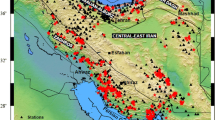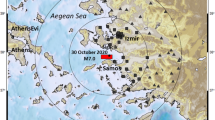Abstract
Groningen gas field, which is being exploited for more than five decades, has been experiencing shallow and small magnitude earthquakes that cause limited structural damage to the building inventory in the region. These earthquakes are recorded in a relatively small area with multiple recording networks, which constitute a dense strong ground motion sensor grid, providing valuable insight into the characteristics of the motions produced by some 2500+ small faults at 3 km depth. The particularities of the Groningen soil, as well as the high seismic vulnerability of the structural inventory, render the Groningen earthquake problem complex, although the magnitudes experienced so far did not exceed 3.6ML. This paper is an attempt to compare the Groningen earthquake records to records from other induced seismicity and natural seismic events with similar characteristics in terms of magnitude, epicentral distance and depth, for identifying systematic differences in terms of component-to-component variability. In order to achieve that, a total of 1831 recording suites (i.e. couples of horizontal components) are used. 201 of these are Groningen records, 1112 are from other induced seismicity events to geothermal, waste water injection and hydraulic fracturing activities, while 517 are from natural earthquakes. The high polarity of the Groningen records, that is previously reported in the literature and represented as component-to-component variability in risk models, is the main focus of this paper. The component-to-component variability constitutes an important step when implementing ground motion models (GMMs) in risk assessment studies. In this study, in agreement with previous research, the component-to-component variances show that the Groningen induced seismicity events present stronger polarity than the other records used for comparison. The other induced seismicity recordings also show high component-to-component variances as compared to the natural events records, but the main difference is that their variances start decreasing in medium-to-long (i.e. above 0.6 s) periods while the variances steadily increase in the case of Groningen records. Furthermore, it is also observed that the component-to-component variances increase considerably when the rotated-to-max-PGA angle, explained in the paper, is used for defining the two horizontal components instead of using components as-recorded or rotated perpendicular to the station back azimuth. A modification to the component-to-component variance model of Groningen GMM v5 has also been proposed in this study for taking into account the orientation of the structural plan directions in respect to the ground motion component directions.










Similar content being viewed by others
Notes
The highest polarity can in fact be found at BZN1 station data from 8th of January 2018 Zeerijp Earthquake when the complete KNMI database is processed. However, after carefully scrutinizing the data and with the help of Elmer Ruigrok and Bernard Dost from KNMI, it was found out that this recorder did not function properly during the earthquake, thus it has been removed from our dataset.
References
Abrahamson NA, Silva WJ, Kamai R (2014) Summary of the Abrahamson, Silva, and Kamai NGA-West2 ground-motion relations for active crustal regions. Earthq Spectra 30:1025–1056
Atkinson GM (2015) Ground-motion prediction equation for small-to-moderate events at short hypocentral distances, with application to induced-seismicity hazards. Bull Seismol Soc Am 105:981–992. https://doi.org/10.1785/0120140142
Atkinson GM, Assatourians K (2017) Are ground-motion models derived from natural events applicable to the estimation of expected motions for induced earthquakes? Seismol Res Lett 88:430–441. https://doi.org/10.1785/0220160153
Atkinson GM, Wald D, Worden CB, Quitoriano V (2018) The intensity signature of induced seismicity. Bull Seismol Soc Am 108:1–7. https://doi.org/10.1785/0120170316
Beyer K, Bommer JJ (2007) Selection and scaling of real accelerograms for bi-directional loading: a review of current practice and code provisions. J Earthq Eng 11:13–45
Beyreuther M, Barsch R, Krischer L, Megies T, Behr Y, Wassermann J (2010) ObsPy: a Python toolbox for seismology. SRL 81(3):530–533. https://doi.org/10.1785/gssrl.81.3.530
Bommer J, Dost B, Edwards B, Kruiver PP, Meijers P, Ntinalexis M, Rodriguez Marek A, Ruigrok E, Spetzler J, Stafford P (2017a) V4 ground-motion model (GMM) for response spectral accelerations, peak ground velocity and significant duration in the Groningen field. Report prepared for NAM
Bommer JJ, Stafford PJ, Edwards B et al (2017b) Framework for a ground-motion model for induced seismic hazard and risk analysis in the Groningen gas field, the Netherlands. Earthq Spectra 33:481–498. https://doi.org/10.1193/082916EQS138M
Bommer J, Edwards B, Kruiver PP, Rodriguez-Marek A, Stafford PJ, Dost B, Ntinalexis M, Ruigrok E, Spetzler J (2018) V5 ground-motion model for the Groningen field. Report prepared for NAM
Boore DM (2005) Erratum: Equations for estimating horizontal response spectra and peak acceleration from western North American earthquakes: a summary of recent work, by D.M. Boore, W.B. Joyner and T.E. Fumal. Seismol Res Lett 76(3):368–369
Boore DM, Watson-Lamprey J, Abrahamson NA (2006) Orientation-independent measures of ground motion. Bull Seismol Soc Am 94(4A):1502–1511
Bourne SJ, Oates SJ, Bommer JJ et al (2015) A monte carlo method for probabilistic hazard assessment of induced seismicity due to conventional natural gas production. Bull Seismol Soc Am 105:1721–1738. https://doi.org/10.1785/0120140302
Boyd OS, McNamara DE, Hartzell S, Choy G (2017) Influence of lithostatic stress on earthquake stress drops in North America. Bull Seismol Soc Am 107:856–868. https://doi.org/10.1785/0120160219
Campbell KW, Bozorgnia Y (2007) Campbell-Bozorgnia NGA ground motion relations for the geometric mean horizontal component of peak and spectral ground motion parameters. Pacific Earthquake Engineering Research Center, Berkeley
Crowley H, Pinho R (2017) Report on the v5 fragility and consequence models for the Groningen field. Report for NAM
Crowley H, Polidoro B, Pinho R, van Elk J (2017) Framework for developing fragility and consequence models for local personal risk. Earthq Spectra 33:1325–1345. https://doi.org/10.1193/083116EQS140M
Dost B, van Eck T, Haak H (2004) Scaling of peak ground acceleration and peak ground velocity recorded in the Netherlands. Bull Geofis Teor Appl 45(3):153–168
Goertz-Allmann BP, Goertz A, Wiemer S (2011) Stress drop variations of induced earthquakes at the Basel geothermal site. Geophys Res Lett. https://doi.org/10.1029/2011gl047498
Gupta A, Baker JW, Ellsworth WL (2017) Assessing ground-motion amplitudes and attenuation for small-to-moderate induced and tectonic earthquakes in the central and eastern United States. Seismol Res Lett 88(5):1379–1389. https://doi.org/10.1785/0220160199
Hough SE (2014) Shaking from injection-induced earthquakes in the central and eastern United States. Bull Seismol Soc Am 104:2619–2626. https://doi.org/10.1785/0120140099
Kaski KM, Atkinson GM (2017) A comparison of ground-motion characteristics from induced seismic events in Alberta with those in Oklahoma. Seismol Res Lett 88:1570–1585. https://doi.org/10.1785/0220170064
Kraaijpoel D, Dost B (2012) Implications of salt-related propagation and mode conversion effects on the analysis of induced seismicity. J Seismol 17:95–107. https://doi.org/10.1007/s10950-012-9309-4
Pitilakis K, Roumelioti Z, Raptakis D, Manakou M, Liakakis K, Anastasiadis A, Pitilakis D (2013) The EUROSEISTEST strong ground motion database and web portal. Seismol Res Lett 84(5):796–804
Smyrou E, Tasiopoulou P, Bal IE, Gazetas G (2011) Ground motions versus geotechnical and structural damage in the February 2011 Christchurch earthquake. Seismol Res Lett 82:882–892. https://doi.org/10.1785/gssrl.82.6.882
Stafford PJ, Zurek BD, Ntinalexis M, Bommer J (2018) Extensions to the Groningen ground-motion model for seismic risk calculations: component-to-component variability and spatial correlation. Bull Earthq Eng. https://doi.org/10.1007/s10518-018-0425-6
Sumy DF, Neighbors CJ, Cochran ES, Keranen KM (2017) Low stress drops observed for aftershocks of the 2011 Mw5.7 Prague, Oklahoma, earthquake. J Geophys Res Solid Earth 122:3813–3834. https://doi.org/10.1002/2016JB013153
Wu Q, Chapman M, Chen X (2018) Stress-drop variations of induced earthquakes in Oklahoma. Bull Seismol Soc Am 108:1107–1123. https://doi.org/10.1785/0120170335
Yenier E, Atkinson GM (2015) Regionally adjustable generic ground-motion prediction equation based on equivalent point-source simulations: application to central and eastern North America. Bull Seismol Soc Am 105:1989–2009. https://doi.org/10.1785/0120140332
Yenier E, Atkinson GM, Sumy DF (2017) Ground motions for induced earthquakes in Oklahoma. Bull Seismol Soc Am 107:198–215. https://doi.org/10.1785/0120160114
Zaliapin I, Ben-Zion Y (2016) Discriminating characteristics of tectonic and human-induced seismicity. Bull Seismol Soc Am 106:846–859. https://doi.org/10.1785/0120150211
Acknowledgements
The Oklahoma dataset and some of the scripts for processing that data were generously provided by the Resilience Engineering Lead at One Concern, Inc., Dr. Abhineet Gupta. The authors are grateful to his contribution. The authors would like to thank Julian Bommer for the valuable discussion he provided when an earlier version of the work was presented in the GMPE v5 workshop. The authors are grateful to Prof. Bozidar Stojadinovic and Catherine Whyte for helping to find some of the Swiss and US induced seismicity records. Bernard Dost and Elmer Ruigrok from KNMI were helpful in identifying and excluding the problematic data, while Jordi Domingo Ballesta and Janneke van Ginkel from KNMI were helpful in accessing the public KNMI data. Their help is noted with gratitude. A note of gratitude is also due to Gail Atkinson for helping to use the Alberta induced seismicity catalogue. We also gratefully acknowledge the great deal of help by Ahmet Anıl Dindar in using Python codes for processing the seismic data.
Author information
Authors and Affiliations
Corresponding author
Rights and permissions
About this article
Cite this article
Bal, İ.E., Smyrou, E. & Dais, D. Comparison of polarity in Groningen data with that of other natural and induced seismicity records, and implications in hazard and risk models. Bull Earthquake Eng 17, 4457–4474 (2019). https://doi.org/10.1007/s10518-018-0517-3
Received:
Accepted:
Published:
Issue Date:
DOI: https://doi.org/10.1007/s10518-018-0517-3




